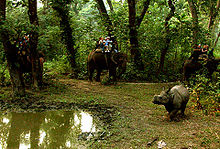

Wildlife tourism is an element of many nations' travel industry centered around observation and interaction with local animal and plant life in their natural habitats. While it can include eco- and animal-friendly tourism, safari hunting and similar high-intervention activities also fall under the umbrella of wildlife tourism. Wildlife tourism, in its simplest sense, is interacting with wild animals in their natural habitat, either actively (e.g. hunting/collection) or passively (e.g. watching/photography). Wildlife tourism is an important part of the tourism industries in many countries including many African and South American countries, Australia, India, Canada, Indonesia, Bangladesh, Malaysia, Sri Lanka and Maldives among many. It has experienced a dramatic and rapid growth in recent years worldwide and many elements are closely aligned to eco-tourism and sustainable tourism.
According to United Nations World Tourism Organization, with an annual growth about 3%, 7% of world tourism industry relates to wildlife tourism.[1] They also estimate that the growth is much more significant in places like UNESCO World Heritage Sites.[1] Wildlife tourism currently employs 22 million people worldwide directly or indirectly, and contributes more than $120 billion to global GDP.[2] As a multimillion-dollar international industry, wildlife tourism is often characterized by the offering of customized tour packages and safaris to allow close access to wildlife.
- ^ a b Scanlon, John (22 June 2017). "The world needs wildlife tourism. But that won't work without wildlife". The Guardian.
- ^ "How Tourism Benefits Nature and Wildlife - Sustainable Travel International". sustainabletravel.org. 25 January 2021. Archived from the original on 25 January 2021.